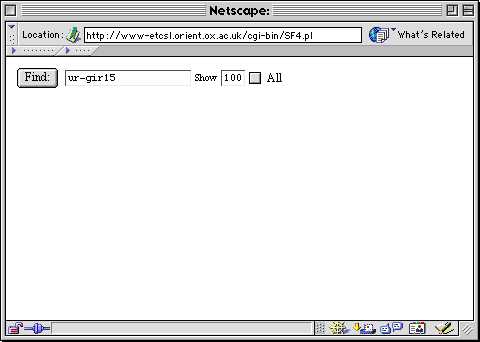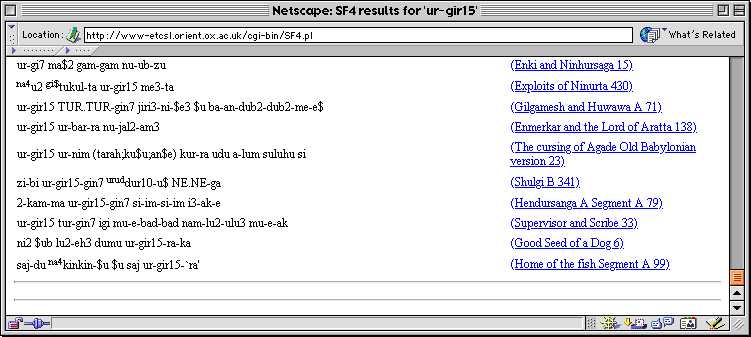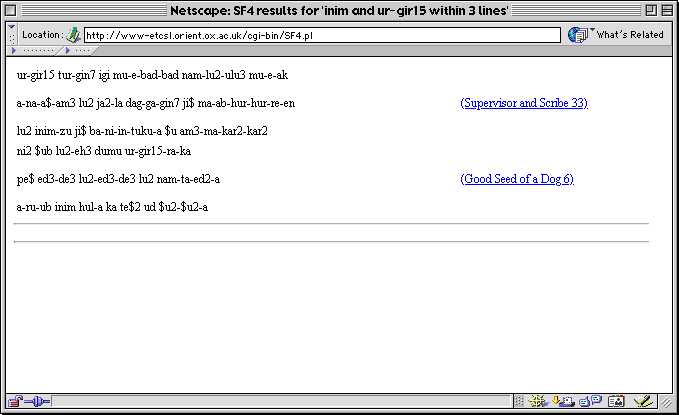The Electronic Text Corpus of Sumerian
Literature
Catalogues: by date | by number | in full |
Website info: navigation help | site description | display
conventions | recent changes
Project info: consolidated
bibliography | credits and copyright | links | Search: composite texts | consolidated bibliography | help with searching
The bibliographical search engine was written by Steve Tinney of the Pennsylvania Sumerian Dictionary Project at the University of Pennsylvania, and implemented with the aid of the University of Oxford's Academic Computing Development Team. It searches an XML version of the corpus of Sumerian composite texts for graphemes (i.e. transliterations of individual cuneiform signs), words, and phrases.
For instance, to find all occurrences of the word ur-gir15 "dog", type ur-gir15 into the search box and click the Find button. (You can control the number of results displayed at once by entering a number in the box marked "Show" before you make your search.)

The results will appear in a new window, showing each line of each composition in which the word ur-gir15 appears. The total number of examples found will be displayed [where?]. If that number exceeds the value you specified in the "Show" box, then click the "more results" at the bottom of the screen to continue viewing the items found. A double horizontal line marks the end of the list.

Clicking on the title of a composition in that second window will cause the whole composition to be displayed in a third window [? currently broken] at the bottom of the screen:
[new image needed]
To start a new search, simply go back to the search window. To view the translation or bibliography of a found composition, open another new window in your browser.
If your search finds no items, then the results window will appear blank except for a double horizontal ruling. If the search engine was unable to process your request, a red error message will appear in the results window.
The search engine uses ASCII encoding for input, so to enter special Sumerian diacritics into the search box type:
The search results are displayed just like the rest of the site (see Display conventions page) with some minor differences:
It is not necessary to be familiar with the ETCSL preferred transliteration values, as the search engine recognises aliases or alternative transliterations for the same grapheme. For instance, in the first example above, entering the search term ur-gi7 instead of ur-gir15 produces the same set of results:

In fact, as you can see in this example, alternative transliterations have occasionally slipped into the corpus too, despite our best proofreading efforts! The full list of aliases is given on a separate page.
The search engine recognises three different ways of separating graphemes in the search input box. Use:

You can use Boolean operators in the input search box to find collocations and non-collocations of graphemes or words. Use:
The and and not operators are both sequence-sensitive. That is, lu2 and ur-gir15 will find only instances in which lu2 precedes ur-gir15 in the same line, while ur-gir15 not lu2 finds only lines in which ur-gir15 precedes lu2.
You can narrow or widen the scope of a Boolean search by adding the following phrases to your search request, where n is any positive or negative whole number. Use:
For instance, lu2 and ur-gir15 within -3 lines will find the following:

For more complex ways of searching the corpus, see Advanced searching with regular expressions.
Back: Searching the consolidated bibliography
Top | Home | Search: composite texts | consolidated bibliography | help with searching
Page created on 29.iii.2002 by ER. Last revised on 12.iv.2002 by ER.